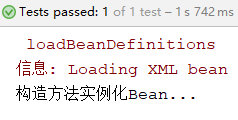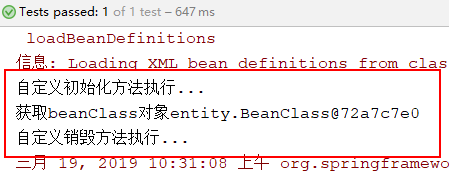1、Bean 的配置
Spring可以看做一个大型工厂,用于生产和管理Spring容器中的Bean,Spring框架支持XML和Properties两种格式的配置文件,在实际开发中常用XML格式的配置文件。
XML配置文件的跟标签是<beans>,<beans>中包含了多个<bean>子元素,每个<bean>元素定义一个Bean,并描述Bean如何被装配到Spring容器中。
<bean>元素的常用属性及其子元素说明如下:
- id属性:Bean在BeanFactory中的唯一标识,在代码中通过BeanFactory获取Bean实例时需要以此作为索引名称;
- name属性:和id属性的用法类似,该属性的值中可以包含特殊字符;
- class属性:Bean的具体实现类,使用类的名(例如 dao.TestDIDaoImpl);
- scope属性:指定Bean实例的作用域;
- <constructor-arg>子元素:<bean>元素的子元素,使用构造方法注入,指定构造方法的参数。该元素的index属性指定参数的序号,ref属性指定对BeanFactory中其他Bean的引用关系,type属性指定参数类型,value属性指定参数的常量值;
- <property>子元素:<bean>元素的子元素,用于设置一个属性。该元素的name属性指定Bean实例中相应的属性名称,value属性指定Bean的属性值,ref属性指定属性对BeanFactory中其他Bean的引用关系;
- <list>子元素:<property>元素的子元素,用于封装List或数组类型的依赖注入;
- <map>子元素:<property>元素的子元素,用于封装Map类型的依赖注入;
- <set>子元素:<property>元素的子元素,用于封装Set类型的依赖注入;
- <entry>子元素:<map>元素的子元素,用于设置一个键值对;
2、Bean 的实例化
Spring框架实例化Bean有3种方法,即构造方法实例化、静态工厂实例化、实例工厂实例化。
2.1、构造方法实例化
在Spring框架中,Spring容器可以调用Bean对应类中的无参构造方法来实例化Bean,这种方法称为构造方法实例化。
在src目录下创建entity包,并创建BeanClass类,代码如下:
package entity; public class BeanClass { public BeanClass() { System.out.println("构造方法实例化Bean..."); } }
在applicationContext.xml中配置Bean
<?xml version="1.0" encoding="UTF-8"?> <beans xmlns="http://www.springframework.org/schema/beans" xmlns:xsi="http://www.w3.org/2001/XMLSchema-instance" xsi:schemaLocation="http://www.springframework.org/schema/beans http://www.springframework.org/schema/beans/spring-beans.xsd"> <!--构造方法实例化Bean--> <bean id="beanClass" class="entity.BeanClass"></bean> </beans>
测试代码
@Test public void demo(){ //初始化Spring容器ApplicationContext,加载配置文件 ApplicationContext application = new ClassPathXmlApplicationContext("applicationContext.xml"); //通过容器获取实例 BeanClass beanClass = (BeanClass) application.getBean("beanClass"); }
运行结果

2.2、静态工厂实例化
创建BeanClass类,代码如下:
package entity; public class BeanClass { public BeanClass(String str){ System.out.println(str); } }
创建静态工厂类,代码如下:
package entity; public class BeanStaticFactory { public static BeanClass createBean(){ return new BeanClass("静态工厂实例化Bean..."); } }
在applicationContext.xml配置静态工厂Bean
<?xml version="1.0" encoding="UTF-8"?> <beans xmlns="http://www.springframework.org/schema/beans" xmlns:xsi="http://www.w3.org/2001/XMLSchema-instance" xsi:schemaLocation="http://www.springframework.org/schema/beans http://www.springframework.org/schema/beans/spring-beans.xsd"> <!--静态工厂实例化Bean,factory-method属性指定静态方法--> <bean id="beanStaticFactory" class="entity.BeanStaticFactory" factory-method="createBean"></bean> </beans>
测试代码
@Test public void demo(){ //初始化Spring容器ApplicationContext,加载配置文件 ApplicationContext application = new ClassPathXmlApplicationContext("applicationContext.xml"); //通过容器获取实例 BeanClass beanClass = (BeanClass) application.getBean("beanStaticFactory"); }
运行结果

2.3、实例工厂实例化
创建BeanClass类,代码如下:
package entity; public class BeanClass { /* public BeanClass() { System.out.println("构造方法实例化Bean..."); }*/ public BeanClass(String str){ System.out.println(str); } }
创建工厂类,代码如下:
package entity; public class BeanFactory { public BeanClass createBean(){ return new BeanClass("实例工厂实例化Bean..."); } }
在applicationContext.xml中添加配置信息
<?xml version="1.0" encoding="UTF-8"?> <beans xmlns="http://www.springframework.org/schema/beans" xmlns:xsi="http://www.w3.org/2001/XMLSchema-instance" xsi:schemaLocation="http://www.springframework.org/schema/beans http://www.springframework.org/schema/beans/spring-beans.xsd"> <!--配置工厂--> <bean id="beanFactory" class="entity.BeanFactory"></bean> <!--实例工厂实例化Bean, factory-bean属性指定配置工厂, factory-method属性指定实例化Bean的方法 --> <bean id="instanceBean" factory-bean="beanFactory" factory-method="createBean"></bean> </beans>
测试代码
@Test public void demo(){ //初始化Spring容器ApplicationContext,加载配置文件 ApplicationContext application = new ClassPathXmlApplicationContext("applicationContext.xml"); //通过容器获取实例 BeanClass beanClass = (BeanClass) application.getBean("instanceBean"); }
运行结果

3、Bean 的作用域
在Spring中不仅可以完成Bean的实例化,还可以为Bean指定作用域,具体用法是在<bean>元素上配置scope属性,属性的值有以下几种:
- sigleton:默认的作用域,使用singleton定义的Bean在Spring容器中只有一个Bean实例,即单例模式;
- prototype:Spring容器每次获取prototype定义的Bean,容器都将创建一个新的Bean实例,即多例模式;
- request:在一次HTTP请求中容器将返回一个Bean实例,不同的HTTP请求返回不同的Bean实例。仅在Web Spring应用程序上下文中使用;
- session:在一个HTTP Session中,容器将返回同一个Bean实例。仅在Web Spring应用程序上下文中使用;
- application:为每个ServletContext对象创建一个实例,即同一个应用共享一个Bean实例。仅在Web Spring应用程序上下文中使用;
- websocket:为每个WebSocket对象创建一个Bean实例。仅在Web Spring应用程序上下文中使用;
4、Bean 的生命周期
Spring初始化bean或销毁bean时,有时需要做一些处理工作,因此Spring可以在创建和销毁bean的时候调用bean的两个生命周期方法,代码示例如下:
创建BeanClass类
package entity; public class BeanClass { public void initMyself(){ System.out.println("自定义初始化方法执行..."); } public void destoryMyself(){ System.out.println("自定义销毁方法执行..."); } }
在applicationContext.xml中配置Bean
<?xml version="1.0" encoding="UTF-8"?> <beans xmlns="http://www.springframework.org/schema/beans" xmlns:xsi="http://www.w3.org/2001/XMLSchema-instance" xsi:schemaLocation="http://www.springframework.org/schema/beans http://www.springframework.org/schema/beans/spring-beans.xsd"> <!--配置bean, 使用init-method属性指定初始化方法, 使用destroy-method属性指定销毁方法 --> <bean id="beanClass" class="entity.BeanClass" init-method="initMyself" destroy-method="destoryMyself"></bean> </beans>
测试代码
@Test public void demo(){ //为了方便演示销毁方法的执行,使用ClassPathXmlApplicationContext ClassPathXmlApplicationContext ctx = new ClassPathXmlApplicationContext("applicationContext.xml"); //通过容器获取实例 BeanClass beanClass = (BeanClass) ctx.getBean("beanClass"); System.out.println("获取beanClass对象"+beanClass); ctx.close();//关闭容器,销毁Bean对象 }
运行结果

5、Bean的装配方式
5.1、基于XML配置的装配
创建BeanClass实体类
public class BeanClass { private String[] arrs;//数组类型 private List<String> list;//List集合类型 private Set<String> set;//Set集合类型 private Map<String,Integer> map;//Map集合类型 private Properties prop;//属性类型 //getter和setter方法 //toString()方法 }
在applicationContext.xml中配置Bean
<?xml version="1.0" encoding="UTF-8"?> <beans xmlns="http://www.springframework.org/schema/beans" xmlns:xsi="http://www.w3.org/2001/XMLSchema-instance" xsi:schemaLocation="http://www.springframework.org/schema/beans http://www.springframework.org/schema/beans/spring-beans.xsd"> <!--集合类型属性注入--> <bean id="beanClass" class="entity.BeanClass"> <!--数组类型--> <property name="arrs"> <list> <value>aa</value> <value>bb</value> </list> </property> <!--List集合--> <property name="list"> <list> <value>111</value> <value>222</value> </list> </property> <!--Set集合--> <property name="set"> <set> <value>aaa</value> <value>bbb</value> </set> </property> <!--Map集合--> <property name="map"> <map> <entry key="aa" value="11"></entry> <entry key="bb" value="22"></entry> </map> </property> <!--Properties属性--> <property name="prop"> <props> <prop key="aa">11</prop> <prop key="bb">22</prop> </props> </property> </bean> </beans>
测试代码
@Test public void demo(){ //初始化Spring容器ApplicationContext,加载配置文件 ClassPathXmlApplicationContext ctx = new ClassPathXmlApplicationContext("applicationContext.xml"); //通过容器获取实例 BeanClass beanClass = (BeanClass) ctx.getBean("beanClass"); System.out.println(beanClass); }
运行结果

5.2、基于注解的装配
在Spring框架中定义了一系列的注解,下面介绍几个常用注解:
- @Component:该注解是一个泛化的概念,仅仅表示一个组件对象(Bean),可以作用在任何层次上;
- @Repository:该注解用于将数据访问层(DAO)的类标识为Bean,即注解数据访问层Bean,其功能与@Component相同;
- @Service:该注解用于标注一个业务逻辑注解类(Service层),其功能与@Component相同;
- @Controller:该注解用于标注一个控制器组件类(Spring MVC的Controller),其功能与@Component相同;
- @Autowired:该注解可以对类成员变量、方法及构造方法进行标注,完成自动装配的工作。通过使用@Autowired来消除setter和getter方法。默认按照Bean的类型进行装配;
- @Resource:该注解与@Autowired的功能一样,区别在于该注解默认是按照名称来装配注入的,只有当找不到与名称匹配的Bean时才会按照类型来装配注入;@Autowired默认按照Bean的类型进行装配,如果想按照名称来装配注入,则需要和@Qualifier一起使用。@Resource注解有两个属性,name属性指定Bean实例名称,type属性指定Bean类型;
- @Qualifier:该注解与@Autowired注解配合使用。当@Autowired注解需要按照名称来装配注入时需要和该注解一起使用,Bean的实例名称由@Qualifier注解的参数指定;
在上面几个注解中,虽然@Repository、@Service、@Controller等注解的功能与@Component注解相同,但为了类的标注层次化更加清晰,在实际开发中推荐使用以下方式进行配置:
- @Repository标注数据访问层(DAO层);
- @Service标注业务逻辑层(Service层);
- @Controller标注控制层;
代码示例如下:
(1)创建Dao层
创建dao包,并创建TestDao接口和接口实现类TestDaoImpl,并将实现类TestDaoImpl使用@Repository注解标注为数据访问层。
TestDao接口,代码如下:
package dao; public interface TestDao { public void save(); }
TestDaoImpl实现类,代码如下:
package dao; import org.springframework.stereotype.Repository; /*如何在Service层中使用@Resource(name="testDao"), @Repository("testDao")中的testDao不能省略 */ @Repository("testDao") public class TestDaoImpl implements TestDao { @Override public void save() { System.out.println("testDao save"); } }
(2)创建Service层
创建service包,并创建TestService接口和接口实现类TestServiceImpl,并将实现类TestServiceImpl使用@Service注解标注为业务逻辑层。
TestService接口,代码如下:
package service; public interface TestService { public void save(); }
TestServiceImpl接口实现类,代码如下:
package service; import dao.TestDao; import org.springframework.stereotype.Service; import javax.annotation.Resource; @Service("testService") public class TestServiceImpl implements TestService { @Resource(name = "testDao") private TestDao testDao; @Override public void save() { testDao.save(); System.out.println("testService save"); } }
(3)创建Controller层
创建controller包,并创建TestController类,将TestController类使用@Controller注解标注为控制器层。
TestController类,代码如下:
package controller; import org.springframework.beans.factory.annotation.Autowired; import org.springframework.stereotype.Controller; import service.TestService; @Controller public class TestController { @Autowired private TestService testService; public void save(){ testService.save(); System.out.println("testController save"); } }
(4)配置注解
在applicationContext.xml中添加context约束,并配置context扫描包
<?xml version="1.0" encoding="UTF-8"?> <beans xmlns="http://www.springframework.org/schema/beans" xmlns:xsi="http://www.w3.org/2001/XMLSchema-instance" xmlns:context="http://www.springframework.org/schema/context" xsi:schemaLocation="http://www.springframework.org/schema/beans http://www.springframework.org/schema/beans/spring-beans.xsd http://www.springframework.org/schema/context http://www.springframework.org/schema/context/spring-context.xsd"> <!--使用context命名空间,通过Spring扫描指定包--> <context:component-scan base-package="dao"></context:component-scan> <context:component-scan base-package="service"></context:component-scan> <context:component-scan base-package="controller"></context:component-scan> </beans>
(5)创建测试类
测试方法,代码如下:
@Test public void demo(){ //初始化Spring容器ApplicationContext,加载配置文件 ClassPathXmlApplicationContext ctx = new ClassPathXmlApplicationContext("applicationContext.xml"); //通过容器获取实例 TestController testCon = (TestController) ctx.getBean("testController"); testCon.save(); }
运行结果:
